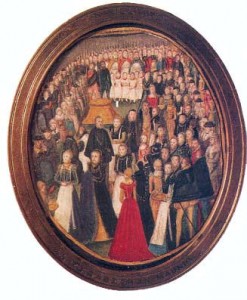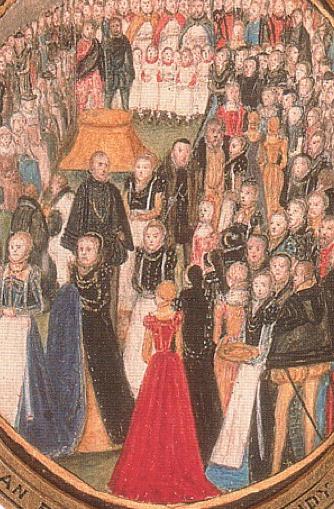In Medieval times "it became customary for the sovereign to provide a meal and to also give gifts of clothing, food, and money to the poor people involved",1 to commemorate Jesus washing the feet of his disciples, long before the reign of Henry VIII this had developed into washing the feet of poor people with the number of people equalling the monarch's age:
"Each year Henry washed the feet of the number of men who equaled his age and gave each of the poor men whose feet he washed a red purse with the number of pence within it that also equaled his age."2
Henry's queens followed the tradition of giving alms to the poor on Maundy Thursday. In March 1535, Anne Boleyn gave alms and there is a letter in Letters and Papers from Sir Edward Chamberlain and Sir Edmund Bedyngfeld to Cromwell telling him that Catherine of Aragon, who was now known as Princess Dowager, "intends to keep a Maundy, in spite of the King's order of last year to the contrary."3 It was no longer her place to give alms to the poor as she was no longer Queen but she was intent on doing so.
Marco Antonio Faitta, secretary to Cardinal Pole, gave an account of Mary I washing feet on Maundy Thursday 1556:
"Her Majesty being accompanied by the right reverend Legate and by the Council, entered a large hall, at the head of which was my Lord Bishop of Ely as Dean (come Decano) of the Queen's chaplains, with the choristers of her Majesty's chapel. Around this hall on either side there were seated on certain benches, with their feet on stools, many poor women, to the number of forty and one, such being the number of the years of the most Serene Queen. Then one of the menials of the Court having washed the right foot of each of these poor persons, and this function being also next performed by the Under Almoner, and also by the Grand Almoner, who is the Bishop of Chichester, her Majesty next commenced the ceremony in the following manner:—
At the entrance of the hall there was a great number of the chief dames and noble ladies of the court, and they prepared themselves by putting on a long linen apron which reached the ground, and round their necks they placed a towel, the two ends of which remained pendant at full length on either side, each of them carrying a silver ewer, and they had flowers in their hands, the Queen also being arrayed in like manner. Her Majesty knelt down on both her knees before the first of the poor women, and taking in the left hand the woman's right foot, she washed it with her own right hand, drying it very thoroughly with the towel which hung at her neck, and having signed it with the cross she kissed the foot so fervently that it seemed as if she were embracing something very precious. She did the like by all and each of the other poor women, one by one, each of the ladies her attendants giving her in turn their basin and ewer and towel; and I vow to you that in all her movements and gestures, and by her manner, she seemed to act thus not merely out of ceremony, but from great feeling and devotion.
Amongst these demonstrations there was this one remarkable, that in washing the feet she went the whole length of that long hall, from one end to the other, ever on her knees. Having finished and risen on her feet, she went back to the head of the hall, and commenced giving in turn to each of the poor women a large wooden platter, with enough food for four persons, filled with great pieces of salted fish, and two large loaves, and thus she went a second time distributing these alms. She next returned a third time, to begin again, giving to each of the women a wooden bowl filled with wine, or rather, I think, hippocras; after which, for the fourth time, she returned and gave to each of these poor people a piece of cloth of royal mixture for clothing (un pezzo di panno mischio di reale per vestire). Then returning for the fifth time she gave to each a pair of shoes and stockings; for the sixth time she gave to each a leathern purse, containing forty-one pennies, according to the number of her own years, and which in value may amount to rather more than half an Italian golden crown; finally, going back for the seventh time, she distributed all the aprons and towels which had been carried by those dames and noble ladies, in number forty-one, giving each with her own hand.
Her Majesty then quitted the hall to take off the gown which she had worn, and half an hour afterwards she returned, being preceded by an attendant carrying the said gown, and thus she went twice round the hall, examining very closely all the poor women one by one, and then returning for the third time she gave the said gown to the one who was in fact the poorest and most aged of them all; and this gown was of the finest purple cloth, lined with martens' fur, and with sleeves so long and wide that they reached the ground. During this ceremony the choristers chaunted the miserere, with certain other psalms, reciting at each verse the words—
“In diebus illis mulier quæ erat in civitate peccatrix.”"4
Elizabeth I continued the tradition and, the Clever Boy will add, thereby doubtless endured the survival of a medieval, and Catholic, custom
A detail from the ministure above.
Queen Elizabeth I is leaving the hall at the bottom left. Together with some of her ladies - the one in the right foreground with a wooden platter - she is wearing the traditional white apron. The choristers in surplces can be seen at the top of the painting. The men in copes behind them may be Chaplains or they could be Gentlemen of hhe Chapel Royal, who are shown wearing them in contemporary pictures.
Image: The Fortnightly Review
Footnotes:
- Levin, Carole (1989) “Would I Could Give You Help and Succour”: Elizabeth I and the Politics of Touch, University of Nebraska, Published in ALBION: A QUARTERLY JOURNAL CONCERNED WITH BRITISH STUDIES, Vol. 21, No. 2 (Summer, 1989), p194.
- Ibid.
- Letters and Papers, Foreign and Domestic, Henry VIII, Volume VIII, 428.
- Calendar of State Papers, Venice, Volume VI, 473, Marco Antonio Faitta to Ippolito Chizzola Doctor in Divinit




No comments:
Post a Comment